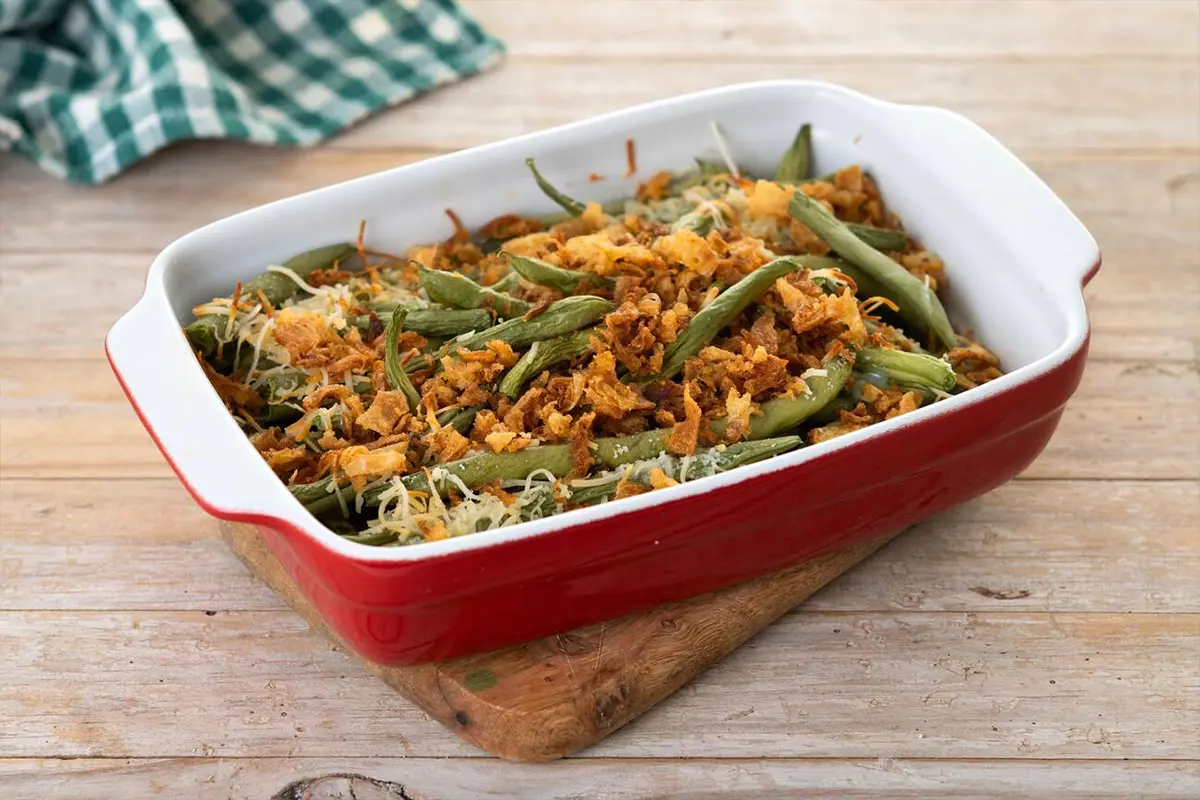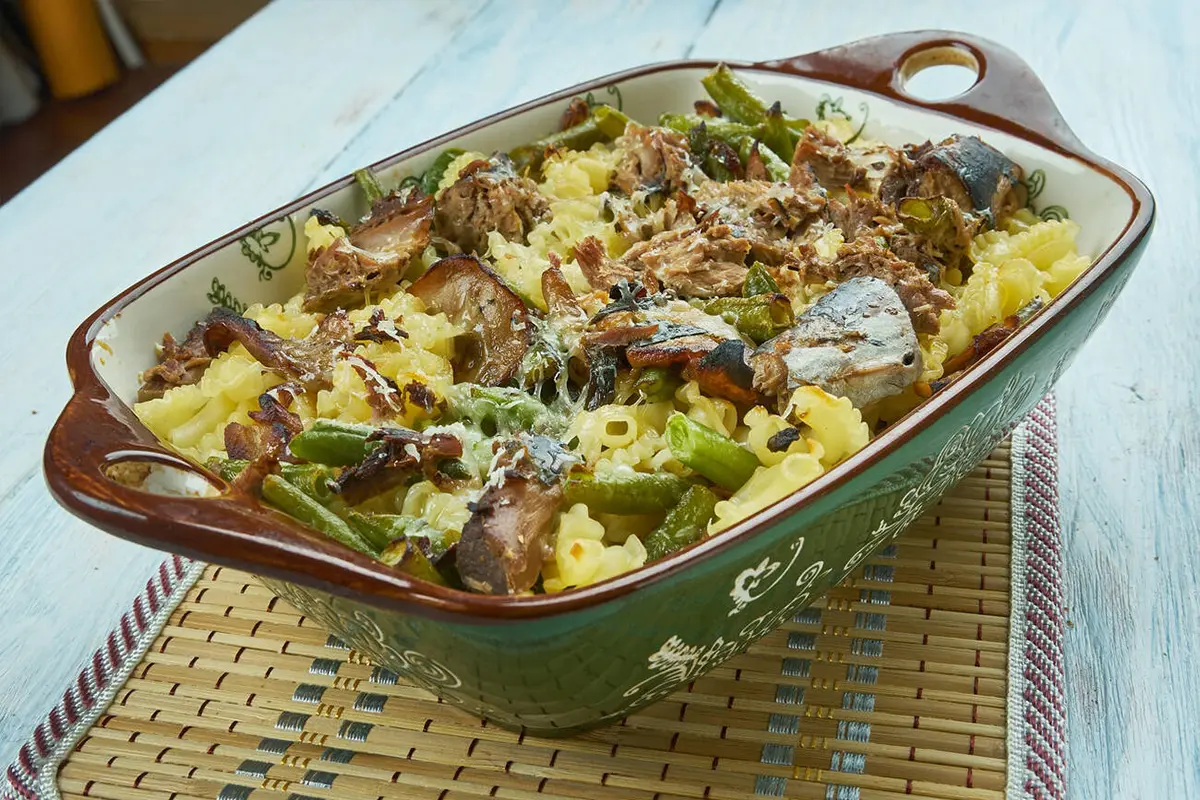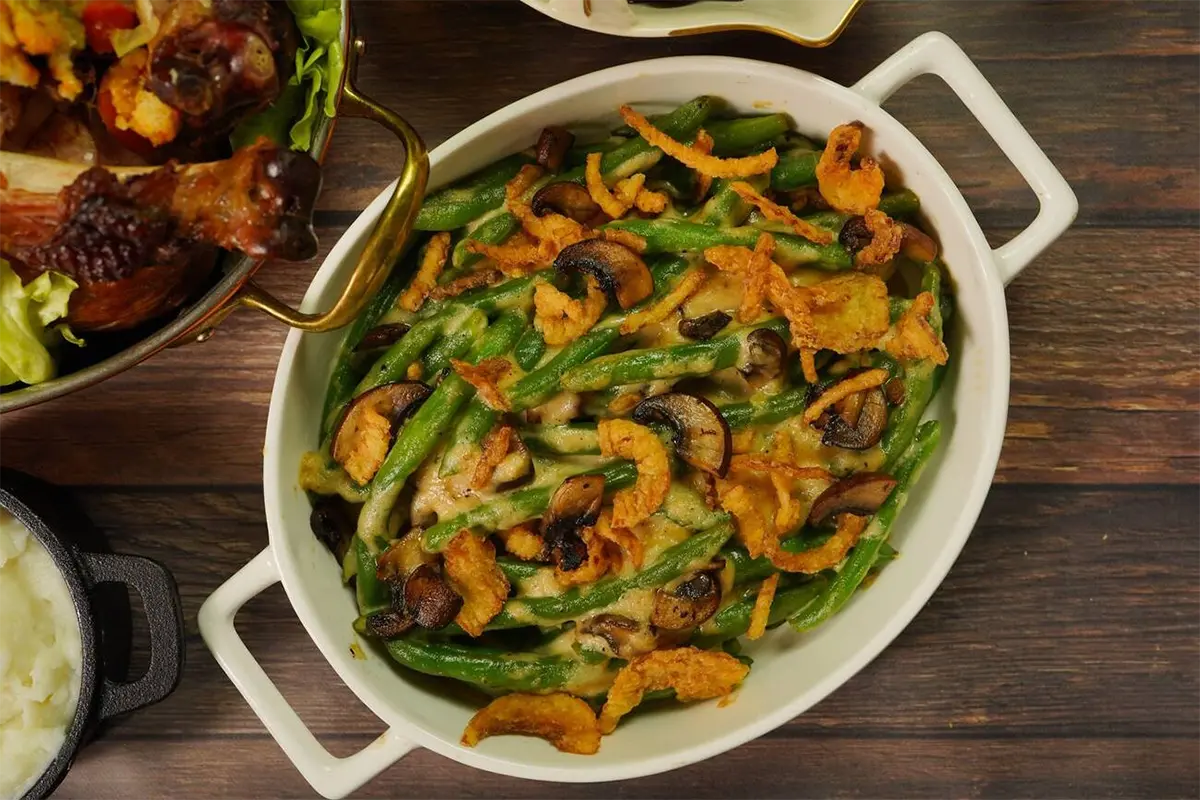A Staple at Holiday Gatherings
As autumn leaves fall and the air turns crisp, it signals the time for holiday preparations. Green Bean Casserole then takes center stage, becoming essential to many holiday meals. Its creamy, comforting presence makes everyone feel at home, which is crucial for gatherings. Moreover, its ease of preparation and the joy it brings further cement its place at the table.
The Universal Appeal of Green Bean Casserole
Why do people across the United States love Green Bean Casserole so much? Its universal appeal stems from a perfect mix of green beans, mushroom soup, and crispy fried onions. This combination not only delivers a delightful array of textures and flavors but also acts as a comforting reminder of family traditions and the joy of eating together. Whether in snowy Maine or sunny California, the casserole remains a favorite, clearly showing how great food can unite us all.
The Roots of Tradition: The Invention of Green Bean Casserole
A Culinary Creation of the 1950s
Green Bean Casserole first appeared in the 1950s, an era marked by culinary innovation aimed at simplifying home cooking. Created by the Campbell Soup Company, this dish was designed to be quick and easy, using ingredients commonly found in any pantry. Moreover, it catered to the American desire for comforting, hearty meals that could be prepared without fuss. This casserole quickly became a beloved addition to family dinners and festive tables alike, symbolizing the era’s gastronomic trends.
The Role of Convenience Foods in American Cooking
The rise of convenience foods reshaped American kitchens during the mid-20th century. Ingredients such as canned soups and processed vegetables became staples, facilitating quicker meal preparation and consistent results. Green Bean Casserole, featuring canned cream of mushroom soup and pre-cut green beans, exemplifies this trend. As a result, it not only saved time but also introduced a new way of cooking that combined convenience with taste. This dish is a prime example of how convenience foods have left a lasting impact on American culinary practices, continuing to influence dishes served across the country.
More Than Just a Dish: The Cultural Impact of Green Bean Casserole
Symbolism in American Holiday Meals
Green Bean Casserole has evolved into more than just a dish; it represents comfort and celebration in American holiday meals. Its presence at Thanksgiving and Christmas symbolizes warmth, family, and tradition. Furthermore, this casserole brings nostalgia and unity to the table, solidifying its role as a holiday staple.
Regional Variations Across the States
Throughout the United States, Green Bean Casserole showcases local flavors and ingredients through its regional variations. In the South, for example, additions like cheddar cheese and bacon are common, whereas in the Midwest, cooks might add wild rice or almond slivers for a distinct flavor. These adaptations highlight the recipe’s versatility and its ability to resonate with diverse cultures and communities, enhancing its widespread appeal.

Step-by-step preparation of Green Bean Casserole, from fresh ingredients to oven
Crafting the Classic: Ingredients of Green Bean Casserole
From Scratch vs. Canned Ingredients
Creating Green Bean Casserole from scratch offers a fresh and flavorful alternative to the traditional canned approach. While many people use canned green beans and mushroom soup for convenience, making the casserole with fresh green beans and homemade mushroom sauce enhances its taste and texture significantly. On the other hand, the classic canned ingredients provide a nostalgic and consistent flavor that many families cherish during the holidays.
Popular Variations and Modern Twists
Green Bean Casserole has evolved with numerous variations and modern twists that cater to diverse tastes and dietary needs. For example, some cooks incorporate gourmet mushrooms like shiitake or porcini to add depth to the flavor, while others might top the casserole with artisanal crispy onions or breadcrumbs for an extra crunch. Additionally, there are now versions that accommodate dietary restrictions, such as gluten-free, vegan, or low-calorie options, ensuring everyone at the table can enjoy this timeless dish. These innovations not only refresh the classic recipe but also make it more inclusive and exciting for everyone.
Homemade Green Bean Casserole: A Step-by-Step Guide
Ingredients List and Preparation
To start, gather the following ingredients for your homemade Green Bean Casserole: fresh green beans, mushrooms, onions, garlic, flour, milk, butter, and crispy fried onions. First, trim and blanch the green beans in boiling water for about 5 minutes, then drain and set aside. In a skillet, sauté chopped mushrooms and onions in butter until they’re soft and golden. Stir in garlic and flour, then slowly add milk to create a thick mushroom sauce.
Cooking Instructions and Serving Suggestions
Preheat your oven to 350 degrees Fahrenheit. Mix the green beans and mushroom sauce in a baking dish, spreading evenly. Bake for 25 minutes. Afterward, sprinkle crispy fried onions on top and bake for an additional 5 minutes, or until the onions are golden and crispy. Serve this classic dish warm, ideally as a side with roasted meats or poultry, making it perfect for holiday gatherings or family dinners.
Tips for the Perfect Casserole
For the best results, use fresh green beans, as they offer better texture and flavor than canned ones. If you prefer a creamier casserole, consider adding a splash of cream to the mushroom sauce. For a crispy topping, try mixing traditional fried onions with breadcrumbs or grated cheese, baking until everything is beautifully golden. With these tips, your Green Bean Casserole will not only taste great but also bring a touch of homemade excellence to your table.
Balancing Tradition and Nutrition
Making Healthier Versions of Green Bean Casserole
When we consider updating our holiday menus, tradition often holds a strong influence. However, it’s equally important to integrate nutritional benefits into these beloved dishes. For instance, the classic green bean casserole can be transformed into a healthier version without losing its cherished flavors.
Firstly, let’s focus on the main component: green beans. Opting for fresh green beans not only enhances the taste but also provides more vitamins and fiber compared to the canned variety. Additionally, you can steam or lightly sauté the beans to maintain their nutritional value and crisp texture.
Moreover, traditional recipes often call for cream of mushroom soup, which is high in sodium and fat. A great alternative is to prepare a homemade mushroom sauce using fresh mushrooms, low-fat milk, and whole-wheat flour. This adjustment not only reduces the calorie count but also increases the dish’s overall nutritional profile.
Furthermore, instead of using fried onions, try topping the casserole with a sprinkle of almond slivers or homemade whole-wheat breadcrumbs for that essential crunch. This swap significantly cuts down on unhealthy fats.
By making these changes, you create a dish that respects tradition while promoting healthier eating habits. Transitioning to healthier versions of your favorite dishes can be a delightful way to enhance well-being during festive seasons.
Mastering Green Bean Casserole: FAQs and Pro Tips
Expert Answers to Commonly Asked Questions
Can I prepare green bean casserole ahead of time?
Absolutely! Assemble the casserole a day in advance, but hold off on adding the topping. Keep it chilled, and then sprinkle the topping on before baking. This step ensures the dish remains fresh and crispy.
What if I want a gluten-free option?
For a gluten-free version, replace the flour in the mushroom sauce with cornstarch. Also, ensure your toppings, like breadcrumbs or fried onions, are gluten-free. Many stores offer suitable alternatives.
Is there a dairy-free modification?
Certainly, you can use almond or oat milk instead of dairy milk in the sauce. Additionally, consider a vegan butter substitute to maintain the rich flavor without using dairy.
Advanced Techniques for Enhanced Flavor
Enhance the umami:
Sauté mushrooms in olive oil with a pinch of salt to deepen their flavor before adding them to the sauce. Including a dash of soy sauce or miso paste can further amplify the umami.
Incorporate fresh herbs:
Add fresh thyme or rosemary to the sauce. These herbs bring a vibrant depth of flavor that dried herbs simply can’t match.
Experiment with cheese:
For those not avoiding dairy, a sprinkle of grated Parmesan or Gruyère in the sauce can add a savory touch that beautifully complements the green beans.
Upgrade your topping:
Mix a little parmesan with your breadcrumbs for the topping. Alternatively, use crushed nuts for a nutritious crunch. These tweaks not only improve the taste but also add a nutritional boost.
By addressing these common questions and employing advanced techniques, you can significantly enhance your green bean casserole. Transitioning to these methods will make your dish a standout at any gathering, ensuring it is as nutritious as it is delicious.
A Holiday Essential: Why Green Bean Casserole Reigns Supreme

A staple at American holiday gatherings, showcasing the creamy texture and crispy onion topping
Thanksgiving and Christmas: A Tradition of Comfort
Green bean casserole, a fixture at American holiday tables, provides more than just comfort food. Introduced in the 1950s, it quickly became a staple for Thanksgiving and Christmas. Its creamy texture and crispy onion topping offer a perfect balance to the rich flavors of holiday meals.
Additionally, its simplicity is a key advantage. Anyone can prepare this dish with just a few ingredients. This accessibility makes it ideal for holiday gatherings of any size. Moreover, its preparation does not require advanced cooking skills, allowing more people to contribute to holiday meals.
Furthermore, green bean casserole is incredibly versatile. You can easily adapt it to include ingredients like cheese, bacon, or almonds. This adaptability ensures it remains a favorite, as it can suit various dietary preferences and tastes.
The Emotional Connection to Green Bean Casserole
The emotional appeal of green bean casserole is profound. For many, it evokes memories of family gatherings and festive cheer. Its presence on the table brings a sense of nostalgia and tradition that enhances the holiday experience.
Moreover, the dish symbolizes unity. It gathers diverse ingredients into a harmonious blend, much like families coming together to celebrate. Sharing this casserole fosters a sense of belonging and comfort among loved ones.
Additionally, the ritual of making and enjoying green bean casserole can be a therapeutic activity during the bustling holiday season. It provides a moment to slow down, engage in a familiar routine, and savor the joy of the holidays.
In conclusion, green bean casserole’s role in American holidays extends beyond its culinary appeal. It is a symbol of comfort, tradition, and emotional warmth, making it a cherished part of holiday celebrations.
The Lasting Legacy of Green Bean Casserole
Why It Remains a Favorite
Green bean casserole continues to captivate with its creamy sauce and crunchy topping. First, its simplicity appeals universally, making it easy to prepare during busy holiday seasons. Next, it’s cost-effective, which appeals to budget-conscious families. Also, the dish’s classic flavor compliments a wide variety of main courses, securing its place at holiday feasts.
Moreover, the recipe’s adaptability contributes to its enduring popularity. Cooks often add personal twists, such as different spices or unique ingredients, which keep the dish fresh and exciting. Furthermore, it suits various dietary needs by substituting ingredients to make it gluten-free, dairy-free, or vegan.
The Future of Green Bean Casserole in American Cuisine
Looking forward, green bean casserole will likely maintain its beloved status. As trends lean towards healthier eating, new versions using organic or locally sourced ingredients are emerging. Additionally, chefs are reinventing traditional dishes, and green bean casserole is no exception, with gourmet versions appearing on restaurant menus.
Also, the growing interest in plant-based diets suggests that green bean casserole could evolve further. Innovations might include more vegan alternatives or the incorporation of superfoods. Lastly, as home cooking gains popularity, this dish will continue to be a gateway for creativity in the kitchen.
In conclusion, green bean casserole’s adaptability and deep-rooted nostalgia suggest it will remain a staple in American cuisine. Its ability to evolve while maintaining its essence guarantees its place at future tables.
LSI and NLP Keywords:
- Green bean casserole recipe, holiday traditions, American cuisine, convenience foods, Thanksgiving recipes, Christmas dinner, homemade casserole, mushroom soup, crispy fried onions, casserole variations, healthy green bean casserole, cultural significance of food, cooking tips, family meals, comfort food, dietary restrictions, vegan green bean casserole, gluten-free options, food history, culinary evolution.
External Links:
- Explore various green bean casserole recipes on Food Network
- Discover a healthier green bean casserole recipe from the Academy of Nutrition and Dietetics
- Find Thanksgiving green bean casserole inspiration at The Spruce Eats

